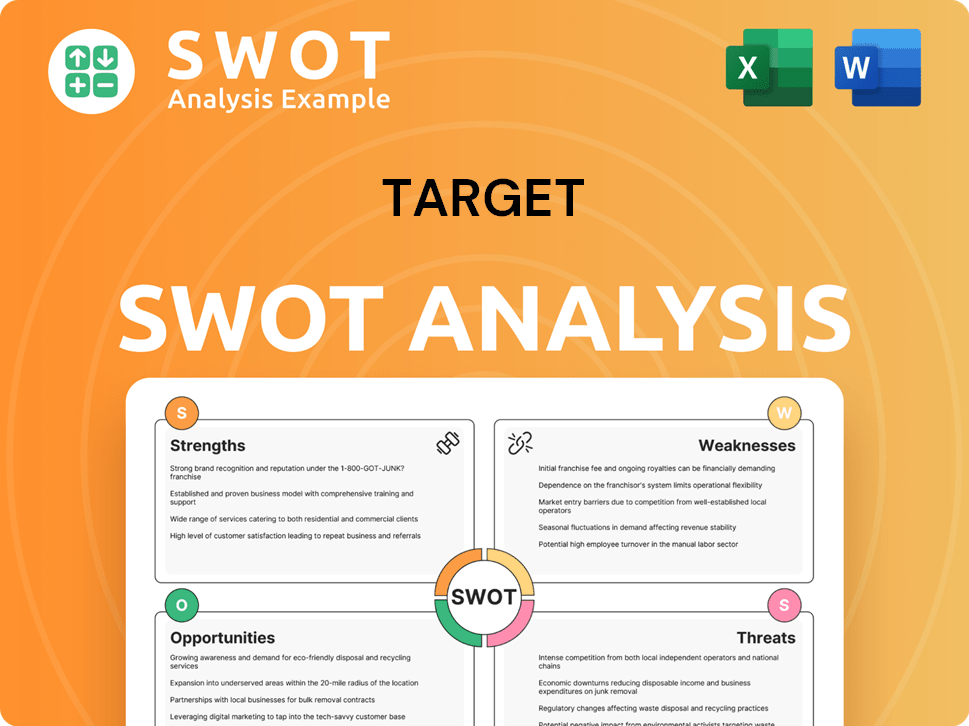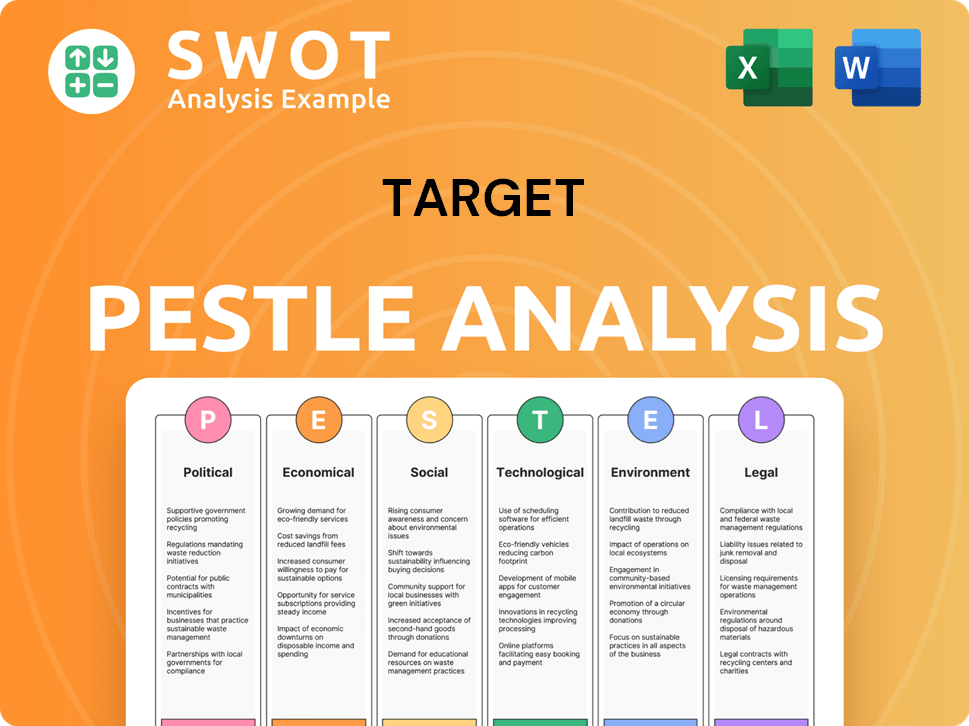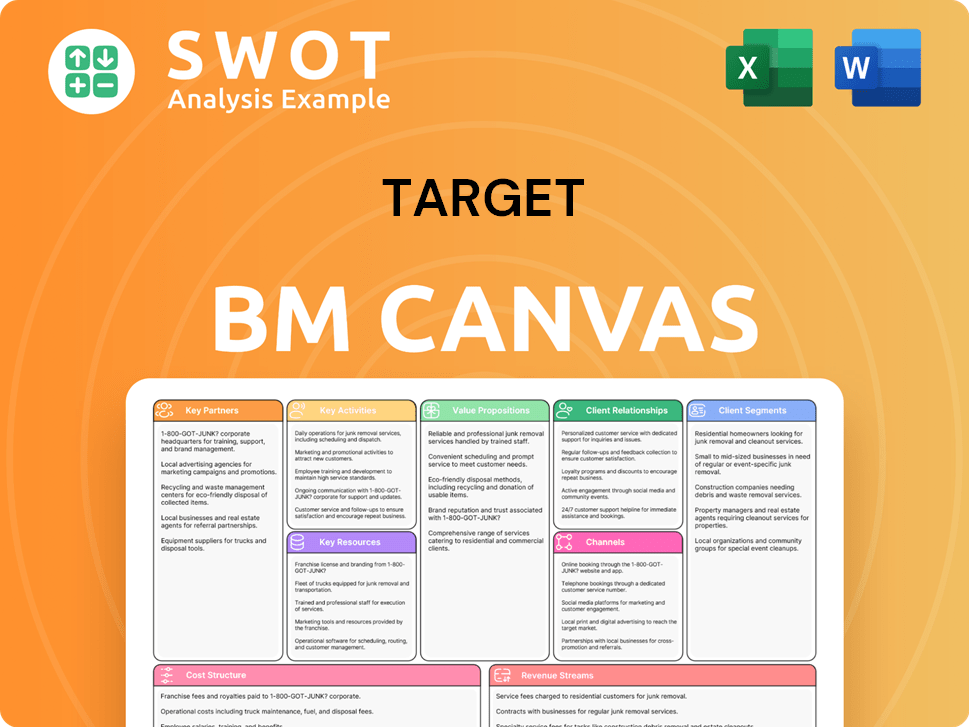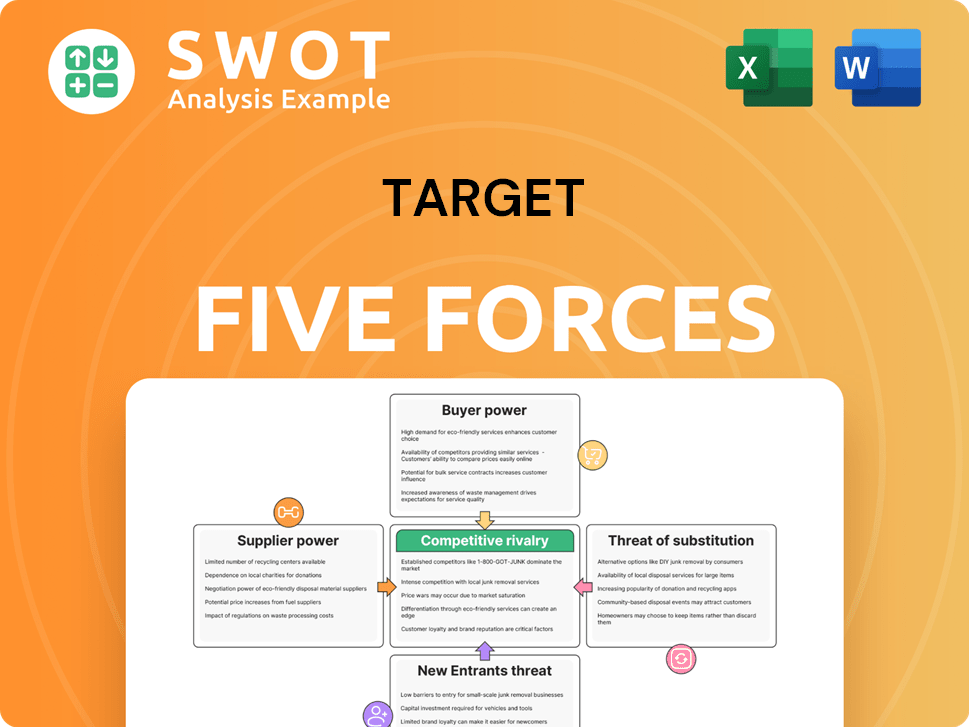Target Bundle
Who Shops at Target? Unveiling the Retail Giant's Customer Base
Understanding the "who" behind the shopping cart is critical for any retailer's success, and for Target, it's a cornerstone of their strategy. This deep dive explores the Target SWOT Analysis, customer demographics, and target market analysis to reveal the core of Target's consumer appeal. We'll dissect the key segments that drive Target's sales and how the company adapts to meet their evolving needs.

From examining Target customer age range and income levels to exploring their geographic location and psychographics, this analysis provides valuable consumer insights. We'll investigate how Target defines its target market, its marketing strategies, and the demographic trends of Target customers in 2024. Ultimately, this exploration will help you understand who the typical Target shopper is and how the company cultivates its ideal customer profile.
Who Are Target’s Main Customers?
Understanding the customer demographics and target market is crucial for any company's success. For the company, this involves a deep dive into who their primary consumers are, their characteristics, and how the company caters to their needs. This detailed analysis allows for effective marketing strategies and product development.
The company primarily serves consumers (B2C), focusing on a broad range of demographics, with a significant emphasis on families. The typical shopper is often characterized as a suburban, Millennial mother with an annual household income around $80,000. However, the company's customer base is diverse, encompassing various age groups, genders, and income levels.
A comprehensive Target market analysis reveals key insights into the company's customer base. The company's ability to adapt to changing consumer preferences and economic conditions is a key factor in its continued success. The company's strategies are designed to maintain customer loyalty and attract new segments.
Age distribution data from March 2025 shows the largest segment is 25-34 year olds, representing 29.56% of the customer base. This is followed by 35-44 year olds at 20.16% and 45-54 year olds at 17.02%. This indicates a broad appeal across different age groups, with a significant portion of the customer base being younger adults.
The gender distribution of the company's customers is nearly balanced. As of March 2025, 51.8% of customers are male, and 48.2% are female. This suggests that the company's product offerings and marketing strategies appeal equally to both genders, creating a balanced customer base.
The company has actively sought to expand its reach beyond its core demographic. Efforts to attract Gen Z consumers, who represented 28% of product development focus in 2024, alongside Millennials at 42%, are notable. The company's expansion of small-format stores in urban areas and near college campuses further demonstrates its strategy to capture younger, more urban populations.
The company's introduction of bargain brands, such as 'dealworthy', and price reductions on thousands of items reflect an effort to cater to budget-conscious consumers. Owned brands, which generated over $30 billion in sales in 2023, are a significant draw. These brands provide a combination of quality, style, and value, appealing to a wide range of customers. To learn more about the company's business model, consider reading Revenue Streams & Business Model of Target.
The company's target market is diverse, with a core focus on families and a growing emphasis on younger consumers. The company's strategic initiatives, including the expansion of small-format stores and the introduction of value-driven brands, demonstrate its commitment to meeting the evolving needs of its customer base. Understanding the customer demographics allows the company to tailor its offerings and marketing efforts effectively.
- The company's customer base is diverse, with a significant portion of Millennials.
- The company is expanding its reach to attract Gen Z consumers.
- The company's owned brands are a major draw for customers, providing value and style.
- The company's marketing strategies are designed to appeal to a broad range of customers.
Target SWOT Analysis
- Complete SWOT Breakdown
- Fully Customizable
- Editable in Excel & Word
- Professional Formatting
- Investor-Ready Format

What Do Target’s Customers Want?
Understanding customer needs and preferences is crucial for the success of any retail business. For the company, this involves a deep dive into what drives their customers' purchasing decisions. The company's approach centers on providing a blend of quality, style, convenience, and value, creating a unique shopping experience.
The company's customers are increasingly omnichannel, valuing the ease of moving between online and in-store shopping. This preference is reflected in the significant growth of their digital sales, particularly through same-day services. Furthermore, the company focuses on personalized experiences and value-driven offerings to meet customer expectations.
The company's success hinges on understanding its customers' needs and preferences. This involves analyzing their buying behaviors, offering personalized experiences, and adapting to market trends. By focusing on these elements, the company aims to maintain and strengthen its connection with its customer base.
Customer buying behavior at the company is heavily influenced by a desire for a 'Tarzhay' experience, combining affordability with a curated feel. This is evident in their omnichannel approach, where customers seamlessly blend online and in-store shopping. The company's focus on convenience is clear, with over 65% of digital sales in 2024 fulfilled through same-day options.
- The company's digital sales saw an 8.7% growth in 2024, indicating the importance of its online presence.
- Same-day delivery services experienced a 25% increase in 2024, highlighting the demand for speed and convenience.
- The company's relaunched Target Circle loyalty program, with over 100 million members, offers personalized deals and exclusive sales.
- The paid Target Circle 360 membership, introduced in April 2024, provides unlimited free same-day delivery for orders over $35.
- The company addresses unmet needs through product development, such as launching over 1,000 new wellness products in 2024.
- Market trends influence product development, with expansions in areas like gaming, sports, toys, home, and beauty in 2025.
- Marketing campaigns are tailored to specific segments, like the spring 2025 campaign transforming stores into a 'garden party'.
Target PESTLE Analysis
- Covers All 6 PESTLE Categories
- No Research Needed – Save Hours of Work
- Built by Experts, Trusted by Consultants
- Instant Download, Ready to Use
- 100% Editable, Fully Customizable

Where does Target operate?
The geographical market presence of the company is exclusively within the United States. The company operates stores across all 50 states and the District of Columbia. As of February 2025, the company has a total of 1,978 stores in the U.S.
A significant portion of the U.S. population lives close to a store. Approximately 80% of U.S. shoppers reside within 10 miles of a store. This widespread coverage is a key factor in the company's accessibility and market penetration.
The company's strategy involves both expanding its physical footprint and enhancing existing locations. This approach aims to reach a broader customer base and improve the overall shopping experience across diverse markets.
The company plans to open over 300 new stores in the next decade. In 2024, they opened 23 new stores. For 2025, they have plans to open an additional 20 stores, with many of these being larger formats.
The company is investing in remodeling a large number of its existing stores. Projects range from full remodels to adding features like Ulta Beauty locations. This strategy aims to enhance the shopping experience and meet the evolving needs of its customer base.
The company utilizes its physical stores for efficient fulfillment of online orders. Over 96% of total sales are fulfilled through stores. This "stores-as-hubs" model provides convenience and reduces fulfillment costs.
The company localizes its offerings and marketing efforts. This includes incorporating sustainable design elements in new stores and investing in features that resonate with local communities. This approach helps in building stronger connections with its customers.
Target Business Model Canvas
- Complete 9-Block Business Model Canvas
- Effortlessly Communicate Your Business Strategy
- Investor-Ready BMC Format
- 100% Editable and Customizable
- Clear and Structured Layout

How Does Target Win & Keep Customers?
The company employs a multifaceted approach to both customer acquisition and retention. This strategy involves a blend of traditional and digital channels, loyalty programs, and personalized shopping experiences. The company's success in these areas is reflected in its financial results and strategic initiatives.
A significant element of the acquisition strategy is the expansion of its physical store network. Plans include opening around 20 new stores in 2025, along with remodeling numerous existing locations. Digital channels are also a key focus, with substantial investments in e-commerce capabilities, app enhancements, and overall online shopping experience improvements. These efforts have contributed to growth in digital sales.
For customer retention, the Target Circle loyalty program plays a central role. Relaunched in April 2024, it offers tiered membership options, including a free tier with personalized deals and the Target Circle Card for extra savings. The paid Target Circle 360 membership offers benefits like same-day delivery, aiming to significantly increase its membership base.
The company plans to open approximately 20 new stores in 2025. This expansion is designed to reach new customers and enhance the in-store shopping experience. Remodeling existing stores is also a key part of this strategy.
Digital sales experienced an 8.7% growth in 2024. This increase highlights the effectiveness of investments in e-commerce, app improvements, and the overall online shopping experience. This growth shows how important digital channels are.
The relaunched Target Circle program, introduced in April 2024, offers multiple membership tiers. These tiers include a free option with personalized deals and the Target Circle Card. The paid membership provides added benefits.
The online marketplace, Target Plus, is projected to grow significantly. It is expected to increase from approximately $1 billion in 2024 to over $5 billion by 2030. This growth will come from adding hundreds of new brands.
The company utilizes customer data and AI to personalize the shopping experience, providing tailored product recommendations and optimized search results. This personalization extends to marketing campaigns, with customized promotions designed to increase customer spending. The in-house media company, Roundel, which generated nearly $2 billion in value in 2024, creates personalized ad campaigns for vendors, appearing on the website, mobile app, and across over 150 premium publishers. The company's focus on private label brands and exclusive partnerships also strengthens its value proposition and customer engagement, contributing to loyalty. Enhancing same-day services, which were its fastest-growing shopping mode in 2024, further demonstrates its focus on convenience and retention. To learn more about the company's overall strategy, you can read about the Growth Strategy of Target.
The company uses customer data and AI to offer personalized shopping experiences. This includes tailored product recommendations and optimized search results. These efforts aim to enhance customer engagement and satisfaction.
Roundel, the in-house media company, generated nearly $2 billion in value in 2024. It creates personalized ad campaigns for vendors. These campaigns appear on the website, mobile app, and other platforms.
The company's focus on private label brands enhances its value proposition. Exclusive partnerships also play a key role in customer engagement. These strategies contribute to customer loyalty and retention.
Same-day services were the fastest-growing shopping mode in 2024. This highlights the company's focus on convenience. Enhancing these services is a key strategy for customer retention.
The paid Target Circle 360 membership offers unlimited free same-day delivery for orders over $35. It also provides other benefits to increase customer retention and loyalty. The company aims to triple its membership base over the next three years.
Target Plus is projected to grow from approximately $1 billion in 2024 to over $5 billion by 2030. This significant growth is anticipated through the addition of hundreds of new brands. This expansion will attract new customers.
Target Porter's Five Forces Analysis
- Covers All 5 Competitive Forces in Detail
- Structured for Consultants, Students, and Founders
- 100% Editable in Microsoft Word & Excel
- Instant Digital Download – Use Immediately
- Compatible with Mac & PC – Fully Unlocked

Related Blogs
- What are Mission Vision & Core Values of Target Company?
- What is Competitive Landscape of Target Company?
- What is Growth Strategy and Future Prospects of Target Company?
- How Does Target Company Work?
- What is Sales and Marketing Strategy of Target Company?
- What is Brief History of Target Company?
- Who Owns Target Company?
Disclaimer
All information, articles, and product details provided on this website are for general informational and educational purposes only. We do not claim any ownership over, nor do we intend to infringe upon, any trademarks, copyrights, logos, brand names, or other intellectual property mentioned or depicted on this site. Such intellectual property remains the property of its respective owners, and any references here are made solely for identification or informational purposes, without implying any affiliation, endorsement, or partnership.
We make no representations or warranties, express or implied, regarding the accuracy, completeness, or suitability of any content or products presented. Nothing on this website should be construed as legal, tax, investment, financial, medical, or other professional advice. In addition, no part of this site—including articles or product references—constitutes a solicitation, recommendation, endorsement, advertisement, or offer to buy or sell any securities, franchises, or other financial instruments, particularly in jurisdictions where such activity would be unlawful.
All content is of a general nature and may not address the specific circumstances of any individual or entity. It is not a substitute for professional advice or services. Any actions you take based on the information provided here are strictly at your own risk. You accept full responsibility for any decisions or outcomes arising from your use of this website and agree to release us from any liability in connection with your use of, or reliance upon, the content or products found herein.